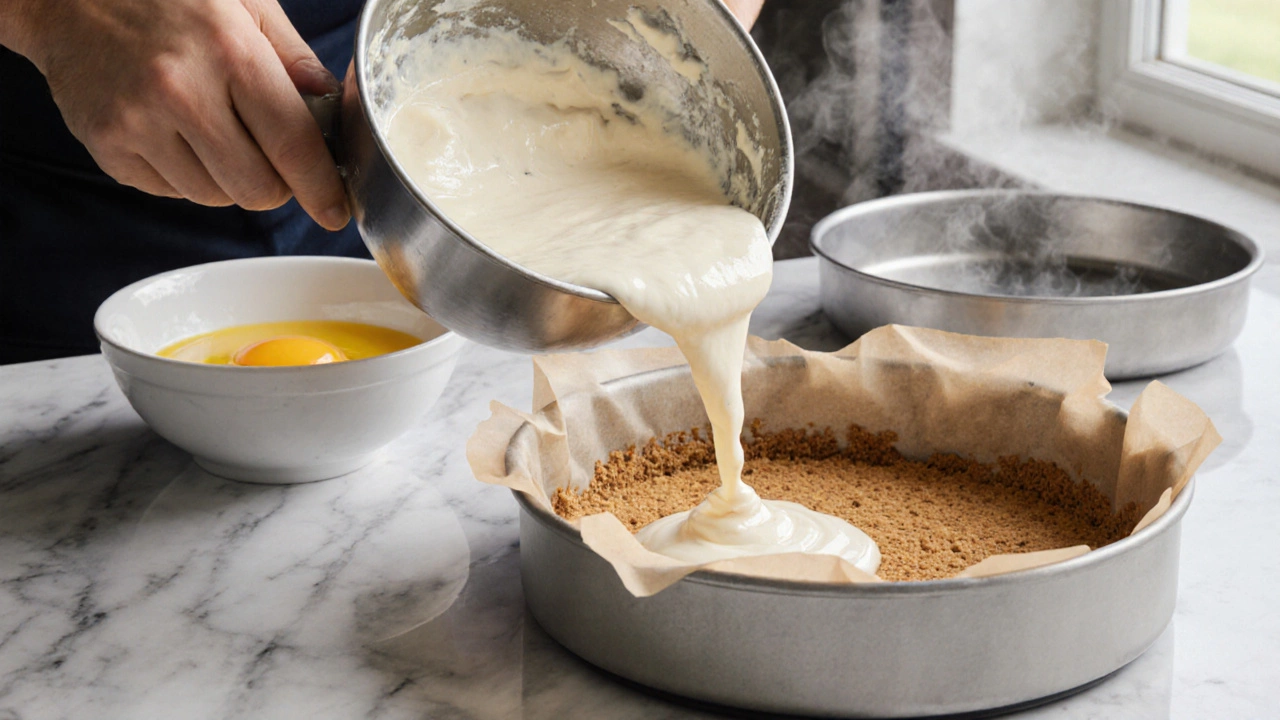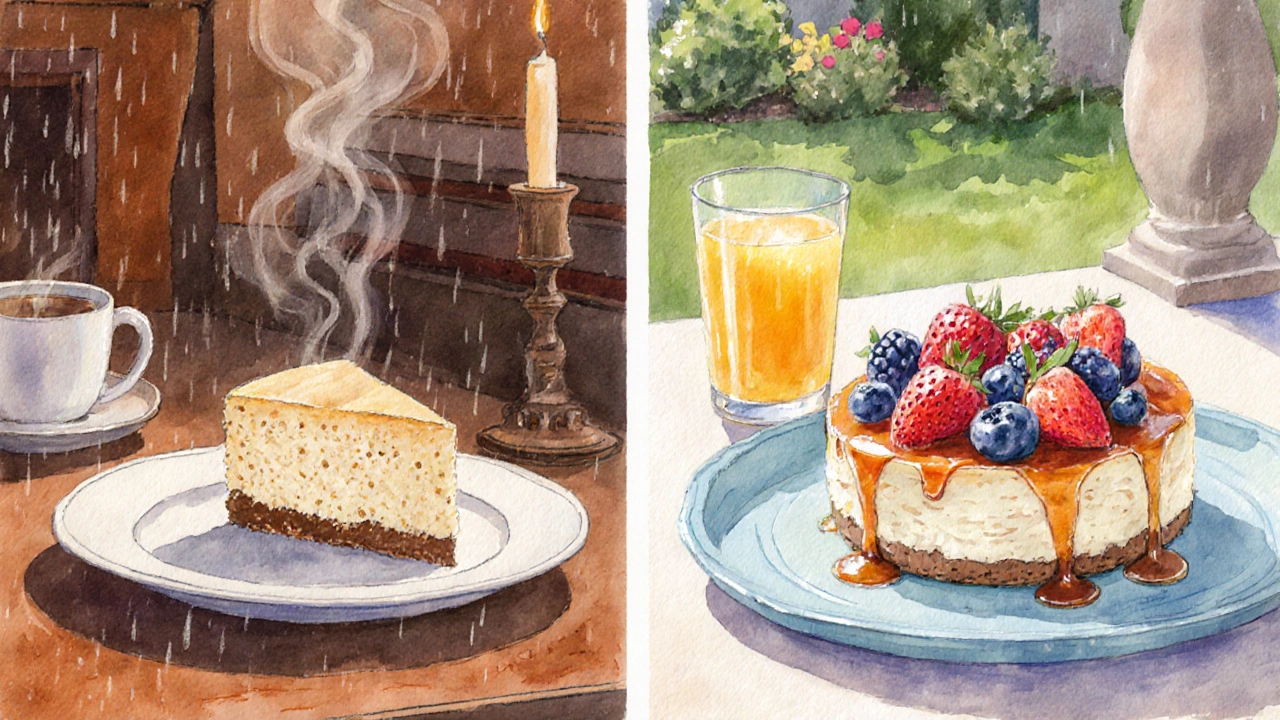Cheesecake Type Selector
Need help deciding between classic (baked) and no-bake cheesecake? Use this selector to find the best option for your situation!
Classic (Baked) Cheesecake
- Texture: Dense, buttery, slightly crumbly edge
- Baking Required: Yes – 45-60 min in water bath
- Risk of Cracks: Moderate – over-baking or rapid cooling
- Ideal Season: Cooler months, comforting desserts
- Prep Time: ~30 min prep + 45 min bake + chilling
No-Bake (Refrigerated) Cheesecake
- Texture: Light, airy, mousse-like
- Baking Required: No – only refrigeration
- Risk of Cracks: Low – no heat stress
- Ideal Season: Warm weather, refreshing treats
- Prep Time: ~20 min prep + 4-6 hr chill
Help Me Choose
Your Recommendation
Key Takeaways
- Cheesecake falls into two core families: baked (classic) and refrigerated (no‑bake).
- Baked cheesecakes use eggs to set, giving a dense, buttery texture.
- No‑bake cheesecakes rely on gelatin or a high‑fat cream cheese mix, resulting in a light, mousse‑like feel.
- The crust is usually a graham cracker crust made from crushed crackers, butter, and sugar.
- Pick a style based on time, equipment, and the occasion you’re serving.
Ever stared at a recipe and wondered whether you should bake your cheesecake or simply chill it? The answer boils down to two primary cheesecake types. Understanding the differences helps you plan ahead, avoid baking mishaps, and pick the perfect version for birthdays, picnics, or a quiet night in.
Cheesecake is a sweet, dense dessert made by blending cream cheese, sugar, and often eggs, then setting the mixture on a crumbly base. While the finish can range from silky smooth to airy light, virtually every cheesecake starts with the same three pillars: a creamy filling, a crunchy crust, and a finishing touch of fruit, chocolate, or caramel.
The Two Core Categories
All cheesecakes belong to one of two families, each with its own chemistry and technique.
Classic (Baked) Cheesecake
Classic cheesecake is a baked version that uses eggs as a natural setting agent, creating a firm yet creamy slice. The process typically involves a water bath (bain‑marie) to moderate heat, preventing the top from cracking.
Key ingredients:
- Cream cheese - full‑fat dairy product, 8‑9% moisture, provides richness
- Eggs - act as a binder and leavening agent, creating structure when heated
- Sugar, vanilla, and often a splash of sour cream or heavy cream for extra smoothness.
The batter is poured over a graham cracker crust and baked at 300‑325°F (150‑160°C). After a gentle cool, the cake is refrigerated for several hours to develop flavor.
No‑Bake (Refrigerated) Cheesecake
No‑bake cheesecake is a chilled version that skips the oven, using gelatin or a high‑fat cream cheese mixture to set. This method produces a softer, mousse‑like texture that’s perfect for summer gatherings.
Key ingredients:
- Cream cheese - same as classic, but often softened and whipped longer.
- Gelatin - unflavored powder dissolved in warm water, provides firmness without heat (or a stabilizer like agar‑agar).
- Heavy cream, condensed milk, and flavor extracts for sweetness and richness.
The mixture is blended, poured onto the same crumbly crust, and left to set in the fridge for 4‑6hours. Because there’s no baking step, the risk of cracks disappears, but you do need to keep the dessert cold until serving.

Side‑by‑Side Comparison
| Attribute | Classic (Baked) | No‑Bake (Refrigerated) |
|---|---|---|
| Setting Agent | Eggs (coagulation through heat) | Gelatin or high‑fat cream cheese mixture |
| Typical Texture | Dense, buttery, slightly crumbly edge | Light, airy, mousse‑like |
| Baking Requirement | Yes - 45‑60min in water bath | No - only refrigeration |
| Risk of Cracks | Moderate - over‑baking or rapid cooling can cause surface cracks | Low - no heat stress |
| Ideal Season | Cooler months, when a richer dessert feels comforting | Warm weather, when a chilled treat is refreshing |
| Preparation Time | ~30min prep + 45min bake + chilling | ~20min prep + 4‑6hr chill |
How to Choose the Right Style
If you have a reliable oven and enjoy a buttery bite, the baked route is rewarding. It’s also the go‑to for traditional flavors like New York‑style vanilla or rich chocolate swirl. On the other hand, if you’re short on time, lack an oven, or want a dessert that won’t melt in summer heat, the no‑bake version wins hands‑down.
Consider these scenarios:
- Family dinner on a rainy night: Classic cheesecake pairs well with coffee and gives that homey feel.
- Outdoor brunch on a sunny Saturday: A chilled no‑bake cheesecake topped with fresh berries stays cool and looks elegant.
- Last‑minute potluck: The no‑bake method lets you assemble in under an hour, then let it set while you finish other dishes.
- Impressing a baking‑savvy guest: A perfectly baked cheesecake with a glossy, crack‑free top demonstrates technique mastery.
Popular Variations and Flavor Boosters
Once you’ve settled on a base style, the sky’s the limit for flavors.
- Fruit topping - fresh strawberries, raspberry coulis, or a mango glaze add acidity and visual pop.
- Chocolate swirl: melt dark chocolate and ripple it into the batter before baking.
- Caramel swirl: a drizzle of salted caramel adds a buttery undertone.
- Matcha or coffee infusion: whisk powdered matcha or espresso into the cream cheese mixture for an adult‑centric twist.
For no‑bake versions, consider incorporating whipped topping to lighten the texture, or blend in cream cheese mousse for an ultra‑fluffy finish.

Pro Tips for Perfect Cheesecakes
- Room‑temperature ingredients: Let cream cheese, eggs, and butter sit out for 30minutes before mixing. This prevents lumps and ensures even baking.
- Don’t over‑mix: Over‑whipping incorporates too much air, which can cause the baked cheesecake to rise and then collapse.
- Water bath (for baked): Wrap the springform pan in foil, place it in a larger pan, and fill the outer pan with hot water. This gentle heat keeps the edges from over‑cooking.
- Cool slowly: After baking, turn the oven off, crack the door, and let the cheesecake sit for 1hour. This gradual cooling reduces cracking.
- Chill thoroughly: Whether baked or not, refrigerate for at least 4hours. The flavor deepens and the texture firms up.
- Use high‑quality cream cheese: Full‑fat (≥33% fat) brands give the richest mouthfeel.
Quick Checklist Before You Start
- Decide between baked or no‑bake based on time, equipment, and season.
- Gather fresh, full‑fat cream cheese and room‑temperature butter.
- Prepare a graham cracker crust (or substitute with crushed digestive biscuits).
- For baked: pre‑heat oven, set up a water bath, and have a cooling rack ready.
- For no‑bake: dissolve gelatin in warm water, have a sturdy mixing bowl, and ensure the fridge is at least 35°F (2°C).
- Plan toppings: fresh fruit, chocolate, or caramel - add just before serving.
Frequently Asked Questions
Can I freeze a baked cheesecake?
Yes. Wrap the cooled, sliced cheesecake tightly in plastic wrap and then foil. It’ll keep for up to 2 months. Thaw in the refrigerator overnight before serving.
Do I need gelatin for a no‑bake cheesecake?
Gelatin is the most common stabilizer, but you can substitute agar‑agar (vegetarian) or use a higher ratio of heavy cream and chilled whipping to achieve firmness without any gelling agent.
Why does my baked cheesecake crack?
Cracks usually happen when the cake cools too quickly or is over‑baked. Using a water bath, cooling slowly in the turned‑off oven, and avoiding over‑mixing help prevent this.
Can I make a gluten‑free crust?
Absolutely. Swap graham crackers for gluten‑free oat cookies or almond flour mixed with butter and a touch of sugar. The texture stays crisp.
What’s the secret to a silky texture?
Use full‑fat cream cheese, avoid over‑beating, and add a spoonful of sour cream or Greek yogurt. The extra fat and slight acidity smooth out any graininess.
Now you’ve got the lowdown on the two main cheesecake families, how they differ, and when each shines. Whether you fire up the oven or keep it chill, you can craft a dessert that looks impressive and tastes unforgettable.